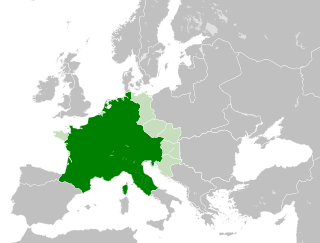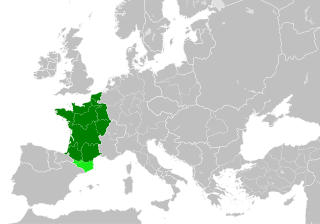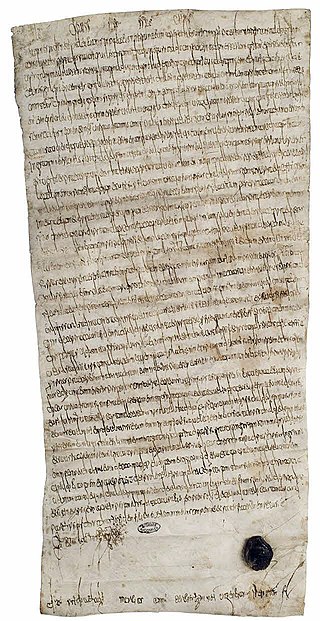
Louis the Pious, also called the Fair and the Debonaire, was King of the Franks and co-emperor with his father, Charlemagne, from 813. He was also King of Aquitaine from 781. As the only surviving son of Charlemagne and Hildegard, he became the sole ruler of the Franks after his father's death in 814, a position that he held until his death except from November 833 to March 834, when he was deposed.

The Carolingian Empire (800–887) was a Frankish-dominated empire in Western and Central Europe during the Early Middle Ages. It was ruled by the Carolingian dynasty, which had ruled as kings of the Franks since 751 and as kings of the Lombards in Italy from 774. In 800, the Frankish king Charlemagne was crowned emperor in Rome by Pope Leo III in an effort to transfer the Roman Empire from the Byzantine Empire to Western Europe. The Carolingian Empire is sometimes considered the first phase in the history of the Holy Roman Empire.

A thing, also known as a folkmoot, assembly, tribal council, and by other names, was a governing assembly in early Germanic society, made up of the free people of the community presided over by a lawspeaker. Things took place at regular intervals, usually at prominent places that were accessible by travel. They provided legislative functions, as well as being social events and opportunities for trade. In modern usage, the meaning of this word in English and other languages has shifted to mean not just an assemblage of some sort but simply an object of any sort.

The Kingdom of the Franks, also known as the Frankish Kingdom, the Frankish Empire or Francia, was the largest post-Roman barbarian kingdom in Western Europe. It was ruled by the Frankish Merovingian and Carolingian dynasties during the Early Middle Ages. Francia was among the last surviving Germanic kingdoms from the Migration Period era.

The Kingdom of France in the Middle Ages was marked by the fragmentation of the Carolingian Empire and West Francia (843–987); the expansion of royal control by the House of Capet (987–1328), including their struggles with the virtually independent principalities, and the creation and extension of administrative/state control in the 13th century; and the rise of the House of Valois (1328–1589), including the protracted dynastic crisis against the House of Plantagenet and their Angevin Empire, culminating in the Hundred Years' War (1337–1453), which laid the seeds for a more centralized and expanded state in the early modern period and the creation of a sense of French identity.

Clovis IV was the king of the Franks from 690 or 691 until his death. If the brief reign of Clovis III (675) is ignored as a usurpation, then Clovis IV may be numbered Clovis III.
The curia regis, Latin for "the royal council" or "king's court", was the name given to councils of advisers and administrators in medieval Europe who served kings, including kings of France, Norman kings of England and Sicily, kings of Poland and the kings and queens of Scotland.

East Francia or the Kingdom of the East Franks was a successor state of Charlemagne's empire ruled by the Carolingian dynasty until 911. It was created through the Treaty of Verdun (843) which divided the former empire into three kingdoms.
A capitulary was a series of legislative or administrative acts emanating from the Frankish court of the Merovingian and Carolingian dynasties, especially that of Charlemagne, the first emperor of the Romans in the west since the collapse of the Western Roman Empire in the late 5th century. They were so called because they were formally divided into sections called capitula.

The Principality of Catalonia was a medieval and early modern state in the northeastern Iberian Peninsula. During most of its history it was in dynastic union with the Kingdom of Aragon, constituting together the Crown of Aragon. Between the 13th and the 18th centuries, it was bordered by the Kingdom of Aragon to the west, the Kingdom of Valencia to the south, the Kingdom of France and the feudal lordship of Andorra to the north and by the Mediterranean Sea to the east. The term Principality of Catalonia was official until the 1830s, when the Spanish government implemented the centralized provincial division, but remained in popular and informal contexts. Today, the term Principat (Principality) is used primarily to refer to the autonomous community of Catalonia in Spain, as distinct from the other Catalan Countries, and usually including the historical region of Roussillon in Southern France.

During the Middle Ages, an advocatus was an office-holder who was legally delegated to perform some of the secular responsibilities of a major feudal lord, or for an institution such as an abbey. Many such positions developed, especially in the Holy Roman Empire. Typically, these evolved to include responsibility for aspects of the daily management of agricultural lands, villages and cities. In some regions, advocates were governors of large provinces, sometimes distinguished by terms such as Landvogt.

The Kingdom of Germany or German Kingdom was the mostly Germanic-speaking East Frankish kingdom, which was formed by the Treaty of Verdun in 843, especially after the kingship passed from Frankish kings to the Saxon Ottonian dynasty in 919. The king was elected, initially by the rulers of the stem duchies, who generally chose one of their own. After 962, when Otto I was crowned emperor, East Francia formed the bulk of the Holy Roman Empire, which also included the Kingdom of Italy and, after 1032, the Kingdom of Burgundy.

The Paladins, also called the Twelve Peers, are twelve legendary knights, the foremost members of Charlemagne's court in the 8th century. They first appear in the medieval chanson de geste cycle of the Matter of France, where they play a similar role to the Knights of the Round Table in Arthurian romance. In these romantic portrayals, the chivalric paladins represent Christianity against a Saracen (Muslim) invasion of Europe. The names of the paladins vary between sources, but there are always twelve of them led by Roland. The paladins' most influential appearance is in The Song of Roland, written between 1050 and 1115, which narrates the heroic death of Roland at the Battle of Roncevaux Pass.
The ispán or count was the leader of a castle district in the Kingdom of Hungary from the early 11th century. Most of them were also heads of the basic administrative units of the kingdom, called counties, and from the 13th century the latter function became dominant. The ispáns were appointed and dismissed by either the monarchs or a high-ranking royal official responsible for the administration of a larger territorial unit within the kingdom. They fulfilled administrative, judicial and military functions in one or more counties.
In the Middle Ages, the ban or banality was originally the power to command men in war and evolved into the general authority to order and to punish. As such, it was the basis for the raising of armies and the exercise of justice. The word is of Germanic origin and first appears in fifth-century law codes. Under the Franks it was a royal prerogative, but could be delegated and, from the tenth century, was frequently usurped by lesser nobles.
The Admonitio generalis is a collection of legislation known as a capitulary issued by Charlemagne in 789, which covers educational and ecclesiastical reform within the Frankish kingdom. Capitularies were used in the Frankish kingdom during the Carolingian dynasty by government and administration bodies and covered a variety of topics, sorted into chapters. Admonitio generalis is actually just one of many Charlemagne's capitularies that outlined his desire for a well-governed, disciplined Christian Frankish kingdom. The reforms issued in these capitularies by Charlemagne during the late 8th century reflect the cultural revival known as the Carolingian Renaissance.

The Transylvanian Diet was an important legislative, administrative and judicial body of the Principality of Transylvania between 1570 and 1867. The general assemblies of the Transylvanian noblemen and the joint assemblies of the representatives of the "Three Nations of Transylvania"—the noblemen, Székelys and Saxons—gave rise to its development. After the disintegration of the medieval Kingdom of Hungary in 1541, delegates from the counties of the eastern and northeastern territories of Hungary proper also attained the Transylvanian Diet, transforming it into a legal successor of the medieval Diets of Hungary.
The Landstände or Landtage were the various territorial estates or diets in the Holy Roman Empire in the Middle Ages and the early modern period, as opposed to their respective territorial lords.
The royal household of the early kings of the Franks is the subject of considerable discussion and remains controversial. This discussion is aimed at identifying the major categories of participants in the administration and those who made the major historical impacts. Every king of the Franks from Clovis I to Charles the Bald had a large cadre of advisors and bureaucrats that helped implement their regime. These supporters of the crown are frequently unknown, but often are ancestors of the later rulers of France. This is not intended to be a complete list of those supporting the kings but to serve as a guide for further study. A general discussion of the Merovingian and Carolingian dynasties can be found in the associated main articles. See also Government of the Carolingian Empire.
The Landgericht, also called the Landtag in Switzerland, was a regional magistracy or court in the Holy Roman Empire that was responsible for high justice within a territory, such as a county (Grafschaft), on behalf of the territorial lord.